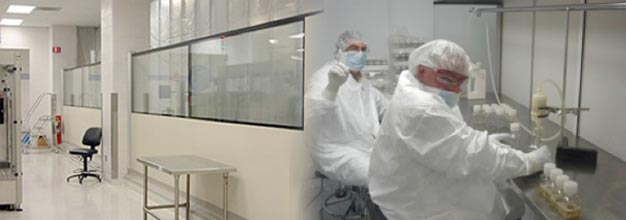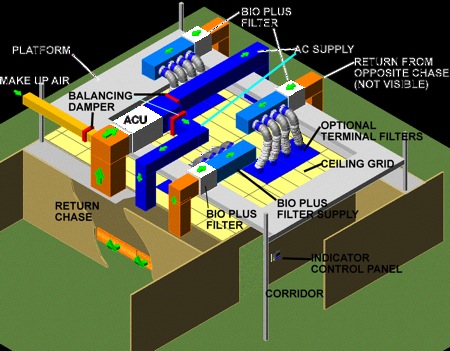Ivey Air can layout and design any of you needs for clean room application. A proper HVAC system is a critical part of clean room design. Even though various design guidelines and standards are available, there is no clear-cut guidelines for many crucial HVAC design parameters, particularly air changes per hour for specific class of clean rooms. FDA guidelines only specify a minimum of 20 air changes per hour for controlled areas without providing any specifics.

Clean room Fundamentals
The fundamentals of clean room design are to control the concentration of airborne particles. The particulate matter comes from several sources: the supply air; the internal particle generation; and infiltration from adjacent spaces. To control these airborne particles, all three sources need to be controlled.
Supply Air Controls
Particles from supply air are easily controlled by using HEPA (high-efficiency particulate air) filters. Most HEPA filters have a minimum efficiency of 99.97% tested on 0.3 micron particles. In other words, only less than 0.03% of all particles of 0.3 microns or larger can get through such a filter. So if the return air contains 10,000 particles per ft3 (353 000 particles per m3) its concentration would be reduced down to three particles per ft3 (106 particles per m3) after it goes through the filter. Therefore, the supply air can be considered almost particulate-free.
Infiltration Controls
Particles from adjacent spaces are also easy to control. If the adjacent area is less clean than the clean room of concern, particle infiltration can be minimized by controlling the airflow direction, so that air flows from the clean room to its adjacent space. This can be easily accomplished by supplying more air than returning air, thus slightly pressurizing the room.
Internal Generation Controls
The internal particulate generation always is the focus of any clean room design. The internal generation consists of those from building elements such as walls, floor, ceiling, etc., from equipment and most importantly from operators. The internal generation from building elements can be minimized by using hard-surfaced non-porous materials such as polyvinyl panels, epoxy painted walls, and glass board ceilings. The internal generation from operators can be minimized with proper gowning to shield the human body and street clothing from the surroundings.


